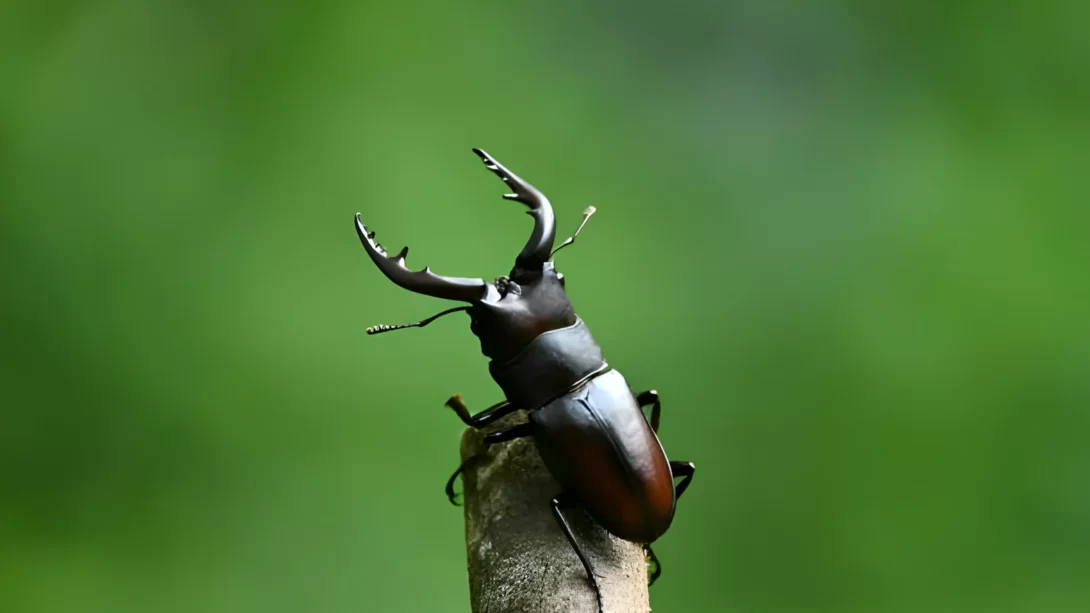Stag beetles, with their impressive, antler-like mandibles, often catch the eye of both seasoned naturalists and casual observers. These large, distinctive beetles are found in a variety of habitats around the world, primarily in woodlands and gardens. Despite their formidable appearance, many people hold misconceptions about their nature and behavior. This article aims to demystify stag beetles, shedding light on their true character and relationship with humans.
Stag Beetles
Stag beetles belong to the family Lucanidae, which comprises several hundred species. They are most recognized for their oversized mandibles, resembling the antlers of a stag, hence their name. These beetles vary in size, but some species can grow up to 3 inches long, making them one of the largest terrestrial insects. The males typically have larger mandibles than the females, which they use for wrestling with other males during the mating season. Stag beetles are predominantly found in Europe, Asia, and North America, with each region hosting its unique species.
The lifecycle of a stag beetle is a fascinating journey. They start as eggs laid in or on rotting wood. The larvae, which are creamy-white grubs, can live in the wood for several years, feeding on the decaying organic matter. This stage is crucial for their development. As they mature, they pupate and finally emerge as adult beetles, ready to continue their species’ lineage.
The Diet and Behavior of Stag Beetles
Contrary to what their fearsome mandibles might suggest, stag beetles are not predators. Their diet mainly consists of tree sap and decaying fruits. They are particularly drawn to the sap that oozes from tree wounds, which serves as a vital source of nourishment. Adult stag beetles, interestingly, have a very short feeding period in their lifecycle, as their primary focus during adulthood is to reproduce.
Stag beetles exhibit unique behavioral patterns, most of which are nocturnal. During the day, they tend to hide under logs or in foliage, emerging at dusk to forage and mate. The males are often seen flying around in search of females during the warm evenings of late spring and early summer. These beetles are generally solitary, with their interactions mostly limited to mating rituals.
Misconceptions and Fears
A common fear about stag beetles stems from their intimidating appearance, especially the male’s large mandibles. However, these are primarily used for show during mating competitions rather than for defense or aggression. Unlike bees or wasps, stag beetles do not sting, and while they can bite if handled improperly, they are not inclined to attack humans. The myths surrounding their danger often overshadow the truth: stag beetles are largely harmless to people.
Comparing stag beetles to other insects considered dangerous, like certain spiders or scorpions, helps put things into perspective. Unlike these creatures, stag beetles do not possess venom or engage in aggressive behavior towards humans. Their presence is often more a curiosity and an opportunity for observation rather than a cause for alarm.
Stag Beetles and Human Interaction
Encounters between stag beetles and humans typically occur in gardens or near wooded areas. In such instances, understanding their behavior is key. Stag beetles might seem aggressive when they open their mandibles wide or move their head in a threatening manner, but this is primarily a defensive display. They are more inclined to flee than fight when approached.
If you do come across a stag beetle, it’s important to remember that they are not a threat to your safety. Observing them from a respectful distance is advisable. Handling them should be done with care, as rough handling can cause them harm, and there’s a small risk of a pinch from their mandibles if they feel threatened.
Environmental Impact and Importance
Stag beetles play a significant role in our ecosystem, particularly in forest environments. As larvae, they contribute to the decomposition process by breaking down dead wood, turning it into nutrient-rich soil that benefits plant growth. This activity helps in maintaining the health of our forests and gardens.
The presence of stag beetles can also be an indicator of a healthy, biodiverse environment. They are a part of a larger web of life, supporting the ecosystem through their role in decomposition and as a food source for other animals like birds and mammals. However, stag beetle populations are facing threats due to habitat loss, pollution, and changes in land use. Understanding their importance is crucial in promoting conservation efforts and ensuring their survival.
Handling and Respect for Stag Beetles
If you find a stag beetle in your garden or during a walk in the woods, it’s important to handle the encounter responsibly. First and foremost, observe without touching. If you need to move a stag beetle, for instance, to relocate it to a safer spot, do so gently, allowing the beetle to crawl onto a piece of paper or a leaf. Avoid handling them directly with your hands unless absolutely necessary, as their bodies are delicate and can be easily damaged.
It’s also crucial to respect their natural habitat. Avoid disrupting areas where they might be breeding or feeding, such as rotting logs or tree stumps. If you’re a garden owner, leaving some natural areas undisturbed can provide a welcoming environment for stag beetles and contribute to their conservation.
What to Do If You Find a Stag Beetle in Your Garden
Discovering a stag beetle in your garden can be an exciting experience and an opportunity to contribute to their conservation. If you find one, consider reporting it to local wildlife groups or conservation societies. These organizations often track sightings to monitor and aid in the preservation of stag beetle populations. Additionally, maintaining a garden that is friendly to stag beetles, with plenty of organic matter and a diversity of plants, can provide them with the necessary habitat for feeding and breeding.
Conclusion
In conclusion, while stag beetles may appear daunting with their large mandibles and size, they pose no real danger to humans. Their presence is a sign of a healthy, biodiverse environment, and their contribution to the ecosystem is invaluable. By understanding their behavior, habitat needs, and importance, we can appreciate these fascinating insects rather than fear them. Embracing coexistence with stag beetles not only enriches our experience of the natural world but also plays a vital role in their conservation and the health of our environment.



